
Journal of Fundamentals of Renewable Energy and Applications
Open Access
ISSN: 2090-4541

ISSN: 2090-4541
Research Article - (2024)Volume 14, Issue 1
This research paper explores the current status of solar power implementation in Uttarakhand, assessing the existing scenario and identifying key challenges and opportunities. Uttarakhand, with its unique geographical and environmental characteristics, holds significant potential for solar energy utilization. The study examines various ongoing solar power projects, their effectiveness, and the socio-economic impact on local communities. Additionally, the paper investigates governmental and private sector schemes aimed at expanding solar power infrastructure in the region. By analyzing these initiatives, the research aims to provide insights into the feasibility, scalability, and sustainability of solar power in Uttarakhand. The findings contribute valuable knowledge for policymakers, energy planners, and stakeholders involved in shaping the future energy landscape of Uttarakhand, emphasizing the importance of diversified and sustainable energy sources in fostering regional development.
Solar energy in Uttarakhand; Sustainable energy; Himalayas; Schemes for solar power; Clean and green energy
Solar power stands as a pivotal asset in the global pursuit of clean energy, playing a transformative role in mitigating the impacts of climate change [1]. The utilization of solar energy involves harnessing the power of the sun through photovoltaic cells or solar thermal systems, offering a sustainable alternative to traditional fossil fuels. As the world grapples with the escalating challenges of climate change, the significance of transitioning to renewable energy sources cannot be overstated [2]. Solar power is a key component in achieving a carbon-neutral future, with the potential to significantly reduce greenhouse gas emissions [3].
The inexhaustible nature of sunlight, coupled with advancements in solar technology, positions solar power as a reliable and eco- friendly energy solution [4]. Renewable energy sources like solar power contribute to the decarbonization of the energy sector, aligning with global efforts to limit temperature rise and combat climate change [5]. As nations strive to meet ambitious clean energy targets, solar power emerges as a vital asset in reshaping the energy landscape and safeguarding the planet for future generations [6]. The United Nations Sustainable Development Goals (SDGs) emphasize the importance of affordable and clean energy (SDG 7) and climate action (SDG 13), further highlighting the significance of solar power in achieving these objectives. As we delve into this renewable energy frontier, it is essential to explore not only the technological aspects but also the socio-economic and environmental implications of widespread solar adoption [7]. This present investigation explores the current state of solar power implementation in Uttarakhand by assessing the existing scenario and different Schemes for its expansion for future potential in reshaping the global energy landscape.
Study Area
The Uttarakhand state came into existence on November 9, 2000, and is subdivided into two regions namely Garhwal and Kumaon. There are thirteen districts in the state, seven in the Garhwal region and six in Kumaon. The Haridwar, Dehradun, Nainital and Udham Singh Nagar contain considerable areas in the plains, while the remaining districts are located in the hill region. The state encompasses an area of 53,483 km2, accounting for about 1.63% of India's total landmass (survey of India, 2022) (Figure 1).
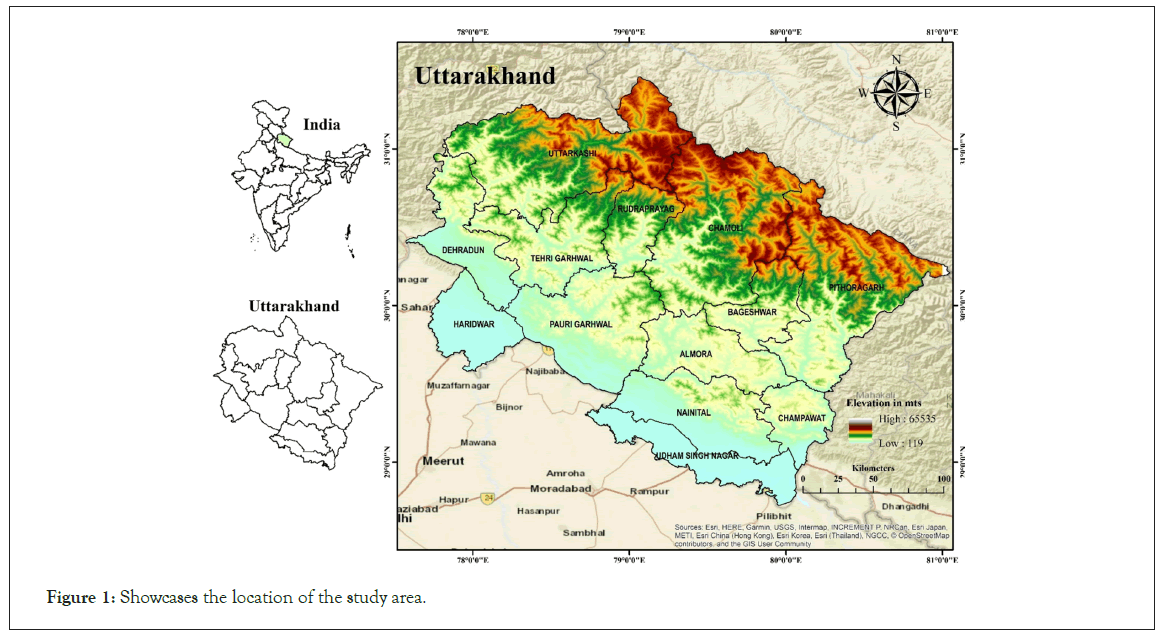
Figure 1: Showcases the location of the study area.
Data sources and methods
The present investigation has been done by utilizing both spatial and non-spatial data. The solar radiation data were retrieved by processing a digital elevation model (Cartoset DEM) in ArcGIS software and classification was done using a spatial analyst tool. To analyse the existing scenario of solar power in the study area, the data such as solar power target and installed capacity were collected from the Uttarakhand Renewable Energy Development Agency (UREDA) and Ministry of New Renewable Energy, GoI (MNRE) and the trend in a solar installation are calculated thereafter. Furthermore, the identification of solar power plants was accomplished through Google Earth Pro and the mapping has been done in GIS softwares.
Solar power potential in Uttarakhand
The state of Uttarakhand in India stands as a beacon of clean and abundant natural resources, particularly in the realm of solar energy for electricity generation. According to the Global Solar Atlas of 2023, the entire state receives a substantial range of solar radiations, varying from 1.9 to 5.9 kWh/m2/day. This diverse range was further delineated into eight categories, ranging from very low to very high, as illustrated (Figure 2). Predominantly, the largest area (61.16%) encompassing districts such as Udham Singh Nagar, Haridwar, Dehradun, Nainital, Champawat, Tehri, Pauri Garhwal, Almora, and Bageshwar, experiences solar radiations in the range of 4.4 to 4.9 kWh/m2. This is followed by 4.9 to 5.4 kWh/m2 (19%), 3.9 to 4.4 kWh/m2 (15.63%), and 3.4 to 3.9 kWh/m2 (3.44%). Notably, a smaller area (0.46%) in regions such as Tehri Garhwal, Pauri Garhwal, Rudraprayag, Almora, Bageshwar, Pithoragarh, and Champawat receives highly concentrated solar radiations ranging from 5.4 to 5.9 kWh/m2, as depicted in Figure 2. These incoming solar radiations underscore the enormous potential of the state to harness solar power for sustainable electricity generation.
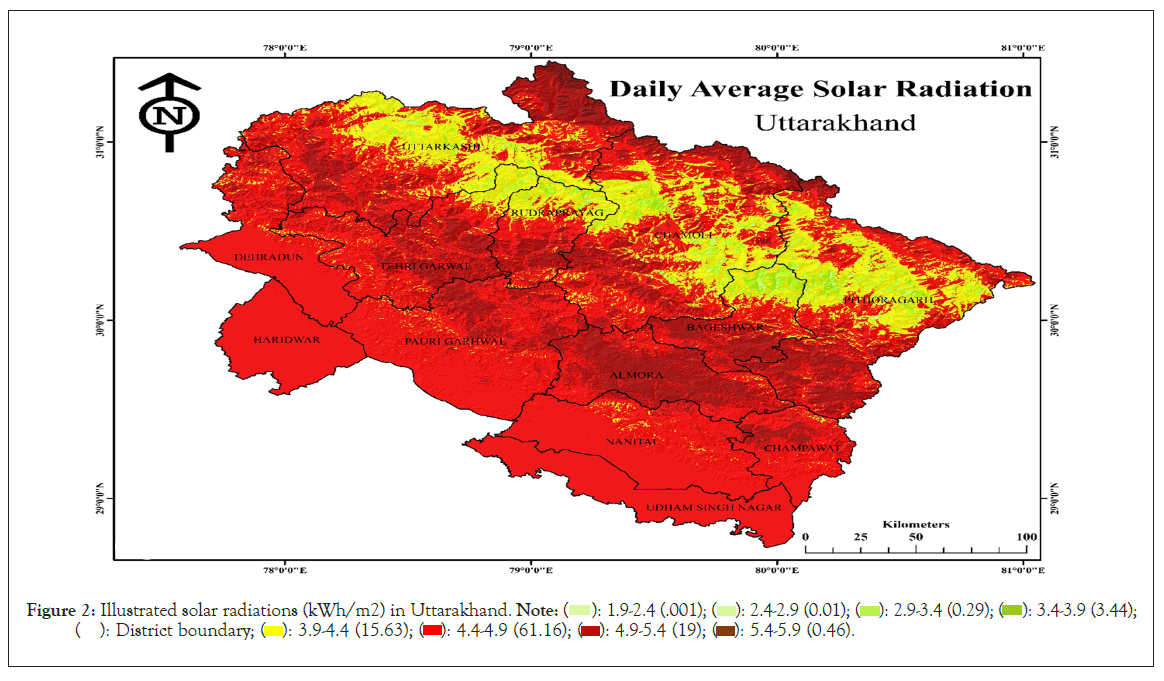
Figure 2: Illustrated solar radiations (kWh/m2) in Uttarakhand. Note: ( ): 1.9-2.4 (.001); (
): 1.9-2.4 (.001); ( ): 2.4-2.9 (0.01); (
): 2.4-2.9 (0.01); (  ): 2.9-3.4 (0.29); (
): 2.9-3.4 (0.29); (  ): 3.4-3.9 (3.44); (
): 3.4-3.9 (3.44); ( ): District boundary; (
): District boundary; (  ): 3.9-4.4 (15.63); (
): 3.9-4.4 (15.63); ( ): 4.4-4.9 (61.16); (
): 4.4-4.9 (61.16); ( ): 4.9-5.4 (19); (
): 4.9-5.4 (19); ( ): 5.4-5.9 (0.46).
): 5.4-5.9 (0.46).
Solar power installed capacity
Uttarakhand, nestled in the Himalayan region, boasts a total installed capacity of 5359.44 MW, as documented by the Ministry of Power GoI, MNRE and UREDA. A significant 74.18% of the state's energy mix is derived from hydropower plants, reflecting the geographical advantage of being a Himalayan state. The contribution of renewable energy sources, totaling 934.09 MW, plays a pivotal role in the state's energy portfolio. Solar power stands out with an impressive 575.53 MW, constituting 10.74% of the installed capacity. This shift towards solar energy aligns with the government's ambitious target of achieving a sustainable and clean energy capacity of 2000 MW by 2028 (Solar policy, 2022). The collaborative efforts of the private, central and state sectors drive Uttarakhand's energy landscape, with respective contributions of 40%, 33% and 27% (Figure 3). The private sector fosters innovation and efficiency through investments in renewable energy projects, the central sector spearheads large-scale national initiatives, while the state sector focuses on utilizing local resources to bolster the region's energy infrastructure. This synergistic collaboration ensures a resilient and diversified energy mix, laying the foundation for Uttarakhand's sustainable development.
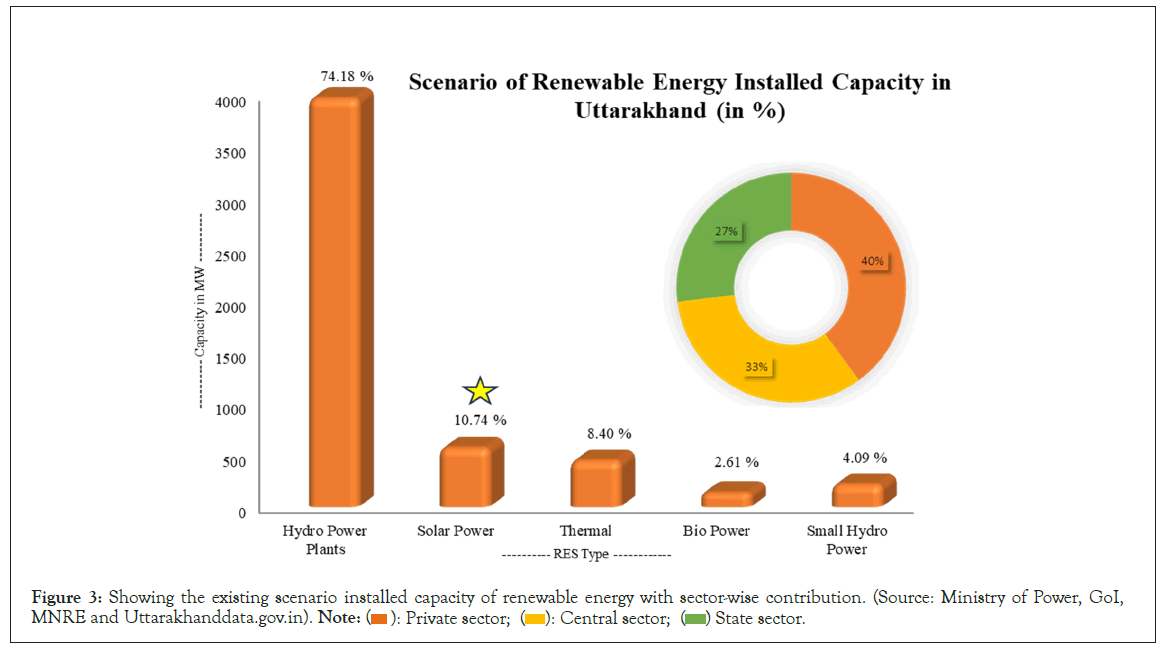
Figure 3: Showing the existing scenario installed capacity of renewable energy with sector-wise contribution. (Source: Ministry of Power, GoI,
MNRE and Uttarakhanddata.gov.in). Note: ( ): Private sector; (
): Private sector; (  ): Central sector; (
): Central sector; ( ) State sector.
) State sector.
In the current financial year of 2022-2023, the state has made significant strides in harnessing solar energy, with an installed capacity totaling 575.53 megawatts (MNRE and UREDA, 2023).
Among this capacity, 561.11 MW (0.90% of the overall SP installed in India), is dedicated to on-grid systems, encompassing both ground-mounted and rooftop installations (Table 1). Notably, these on-grid solar power projects are predominantly concentrated in the low altitudinal region of the state, contributing to the mainstream energy grid. In addition, 14.42 MW is allocated to off-grid solar power plants, specifically rooftop installations. This off-grid capacity is strategically deployed in the hilly regions of the state, where grid connectivity might be challenging. The location of both rooftop and ground-mounted solar power plants is illustrated (Figure 4).
| S. No. | STATES/UTs | GM (MW) | RT (MW) | On-grid (MW) | % (on grid) | Hybrid solar (MW) | Off-grid solar (MW) | Total (MW) |
|---|---|---|---|---|---|---|---|---|
| 1 | Uttarakhand | 298.4 | 262.71 | 561.11 | 0.9 | - | 14.42 | 575.53 |
| 2 | India (MW) | 53802.38 | 8877.93 | 62680.31 | 93.86 | 1707.14 | 2392.91 | 66780.36 |
Table 1: Overall solar power installed capacity in Uttarakhand (source: MNRE and UREDA, 2023).
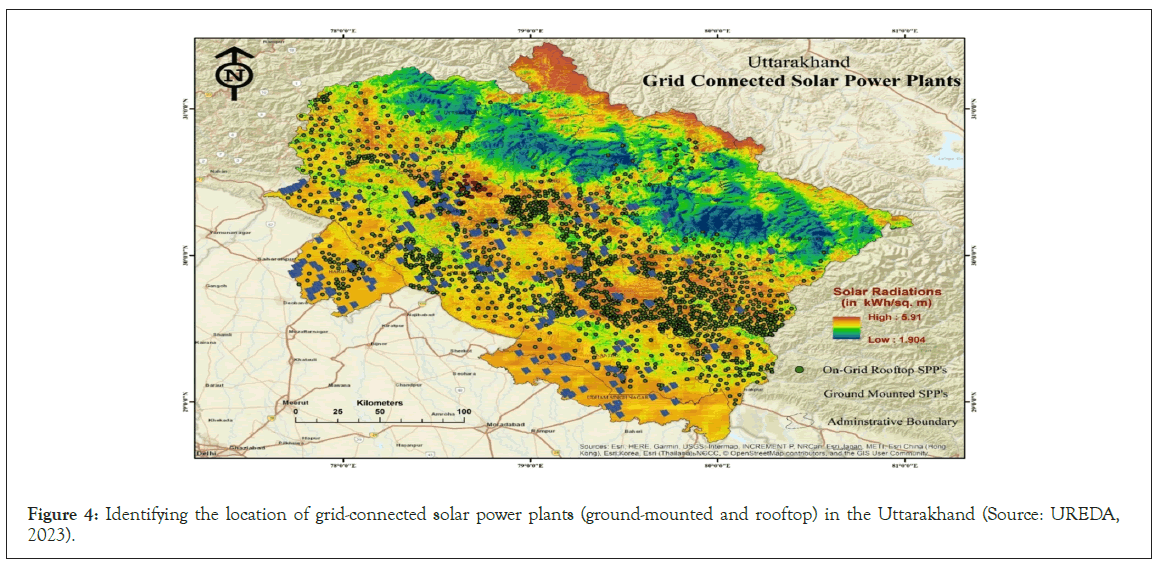
Figure 4: Identifying the location of grid-connected solar power plants (ground-mounted and rooftop) in the Uttarakhand (Source: UREDA, 2023).
Year-wise trend in solar power in Uttarakhand
Over the past several years, the state has witnessed a remarkable surge in its solar installed capacity, indicative of a widespread embrace of solar energy solutions across various sectors. The adoption of solar power systems by residential, commercial and industrial entities has played a pivotal role in this upward trajectory. The data presented in Figure 5 showcases the evolving landscape of solar power capacity from the financial year 2016-2017 to 2022- 2023. Notably, in the initial year of this period, 2016-2017, the installed capacity stood at 45.1 MW. However, owing to significant advancements in technology, improvements in infrastructure, and the government's dedicated initiatives toward promoting green energy, there has been a remarkable upswing. As depicted in Figure 5, the installed capacity has experienced a substantial leap, reaching an impressive 575.53 MW by the financial year 2022-2023.
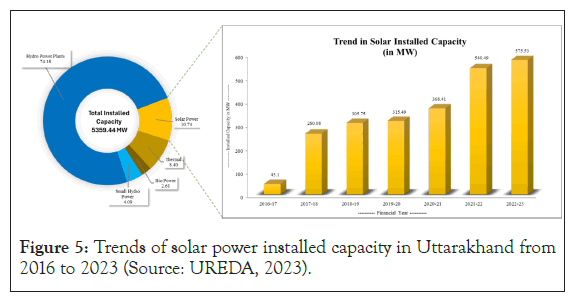
Figure 5: Trends of solar power installed capacity in Uttarakhand from 2016 to 2023 (Source: UREDA, 2023).
Role of different schemes for the expansion of solar power in Uttarakhand
The Uttarakhand Renewable Energy Development Agency (UREDA), established in July 2001, is a pivotal player in advancing renewable energy initiatives within the state. UREDA's multifaceted role encompasses the promotion of renewable energy sources, policy formulation and implementation, project development, capacity building, financial assistance, incentives, research and development, and environmental conservation. To address the imperative of reducing dependence on conventional energy and combating environmental pollution, the Uttarakhand solar policy was enacted in June 2013. Subsequent amendments in 2015 and 2018, along with the establishment of a new solar policy framework in 2022, underline the state's commitment to sustainable energy development. With a visionary target of achieving a cumulative capacity of 2000 MW by 2028, the policy strategically distributes projects across diverse consumer categories, locations, and applications. It also emphasizes the integration of solar plus storage solutions to ensure reliable electricity access in remote rural areas, promoting economic development and employment opportunities. The policy's innovative approaches extend to leveraging tourism and agro-photovoltaics, showcasing a holistic commitment to inclusive and sustainable energy practices. Additionally, targeted training initiatives aim to enhance skill development and create employment opportunities, particularly for at-risk communities. The success of these endeavors is reflected in various power projects launched in 2016-2017, such as the Survoday Swarojgar Yojna and Surya Urja Rooftop Yojana, contributing to self-employment and reduced dependency on grid electricity. The Mukhyamantri Saurya Swarojgar Yojna, initiated in September 2020, further amplifies the state's commitment by providing solar entrepreneurship and self-employment opportunities to small/marginal farmers and unemployed youth. These initiatives underscore Uttarakhand's dedication to sustainable energy, economic growth, and inclusive development.
Solar power has the potential to provide sustainable and reliable energy to Uttarakhand. The investment in solar power represents a significant step forward for the state's energy infrastructure. By expanding its solar power capacity, Uttarakhand has the potential to provide reliable, clean electricity to all residents, including those in remote areas. The state's use of government subsidies and incentives, as well as the involvement of NGOs and other stakeholders, has been key to its success in this area. However, there are still challenges to overcome, such as the high cost of setting up solar power plants and the site suitability for solar power plants in the hilly terrain of the state is required. Despite these challenges, the potential benefits of solar power, such as reducing carbon emissions, providing electricity to rural areas and creating jobs, make it an attractive option for the region. The state’s dedication to this renewable energy source serves as a commendable model for other regions to follow, showcasing the viability and desirability of transitioning towards cleaner and more sustainable energy alternatives.
There are no known competing financial interests or personal ties that may have influenced the research.
The authors would like to thank Indian Council of Social Sciences (ICSSR) for providing doctoral fellowship to the first author.
Citation: Singh S, Negi MS (2024) Sustainable Energy in Himalayas: A Case Study on Solar Power Development in Uttarakhand. J Fundam Renewable Energy Appl. 14:340.
Received: 07-Mar-2024, Manuscript No. JFRA-24-30053; Editor assigned: 11-Mar-2024, Pre QC No. JFRA-24-30053 (PQ); Reviewed: 25-Mar-2024, QC No. JFRA-24-30053; Revised: 01-Apr-2024, Manuscript No. JFRA-24-30053 (R); Published: 08-Apr-2024 , DOI: 10.35248/2090-4541.24.14.340
Copyright: © 2024 Singh S, et al. This is an open-access article distributed under the terms of the Creative Commons Attribution License, which permits unrestricted use, distribution, and reproduction in any medium, provided the original author and source are credited.